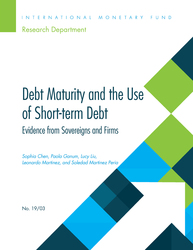
Debt Maturity and the Use of Short-Term Debt: Evidence form Sovereigns and Firms
Maturity structure of debt can have financial and real consequences. Short-term debt exposes borrowers to rollover risk and is associated with financial crises.
READ MORE...
Volume/Issue:
Volume 2019
Issue 001
Publication date: February 2019
ISBN: 9781484380536
$20.00
Add to Cart by clicking price of the language and format you'd like to purchase
Available Languages and Formats
| English |
Topics covered in this book
This title contains information about the following subjects.
Click on a subject if you would like to see other titles with the same subjects.
Money and Monetary Policy , Public Finance , DPPP , DP , short-term debt , maturity , debt maturity , EMDEs , debt , use of short-term debt , average weighted maturity , maturity structure , currency tradeoff , government bond , short-term debt debt ratio , World Bank debt statistics , ratio in AEs , debt dilution problem , bond issuance , weighted average maturity , Syndicated loans , Currencies , Loans , Bonds , Global
Also of interest
Summary
The maturity structure of debt can have financial and real consequences. Short-term debt exposes borrowers to rollover risk (where the terms of financing are renegotiated to the detriment of the borrower) and is associated with financial crises. Moreover, debt maturity can have an impact on the ability of firms to undertake long-term productive investments and, as a result, affect economic activity. The aim of this paper is to examine the evolution and determinants of debt maturity and to characterize differences across countries.
Copyright © 2010 - 2024
Powered by:
AIDC



